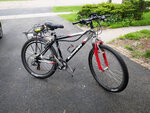See this thread from grintech about bike conversions:
https://electricbikereview.com/forums/threads/why-an-ebike-kit.27333/
Large geared hubs are excellent at grades, and allow one to pedal unpowered without a drag penalty. Small geared hubs are very cheap and not available from US vendors. DD hubs are most of what is sold on e-bay and amazon in cheap power wheel conversion kits. They are heavy, about 15 lb, and in the 1000 W variety as I said, competent at starting on grades. Mine drags me down about 2 sprockets and about 25% of speed versus no motor when I ride it unpowered.
I measured the grade with a 6" level from K-mart, and a scale. Hold the level with one end on the ground, make it level, and measure the distance from the ground of the other end with a scale or ruler. Divide the height measurement by the length measurement. Multiply by 100 to get percent grade.
Fat tire bike geared hub motors have been generally available, but ones that fit a 130 mm rear fork with a 7 speed sprocket cluster have been hard to find in the US. Last month luna had one, but didn't have any when I was buying my geared hub motor. Other vendors are overseas, and I don't send my debit card # to servers that aren't protected by the FBI & US law.
I did the conversion left for $860, with a much bigger battery than you need. As I said, the $189 DD controller is not competent at long trips, but that is not what you are doing, so the low end kits should be fine. My DD power wheel has no PAS, just a throttle, which is not a problem on short trips. Outside of nanny states like Massachusetts & NJ where throttles are illegal. I don't like cheap PAS, the one on my geared hub was too fast (11 mph minimum ) and accelerated too fast (500 w minimum). $5000 torque sensing e-bikes are supposed to be much more natural feeling, but one cannot pedal those bikes unpowered. I pedal most of the time and at age 67, after a $5000 heart evaluation before shoulder surgery, "there is nothing wrong with (my) heart".
